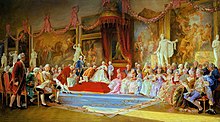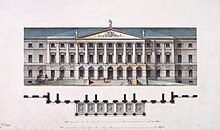Neoclassical architecture in Russia
[3]Scholars recognize that, regardless of the motivation, Catherine found in architecture an embodiment for her aspirations, particularly the so-called Greek Project, which aimed to take Istanbul to recreate a new "Christian Byzantium".[6] In 1763 Catherine commissioned the French architect Jean-Baptiste Vallin de la Mothe and the Russian Alexander Kokorinov for the construction of the new headquarters of the Academy of Fine Arts in St. Petersburg.This idealistic experiment, inspired by the Enlightenment movement, was aimed at creating the "ideal citizen" through the recovery of thousands of orphans who were to receive an adequate education.In 1773, the Empress wrote a letter to the Academy of France, announcing a contest which asked the architects to design a house in which they were present, at the same time, forms of both Greek and Roman antiquities.[13] But if Cameron had been successful for the display of his fanciful polychrome, the heirs of Catherine Paul and Maria Feodorovna forced him to absolute sobriety, so at Pavlovsk became prominent the use of white and gold.Different was the architect's attitude in the most sober Academy of Sciences (1783–1789) where the outside, unadorned, is marked by a heavy porch in Ionic order and in the inside the elegant proportions and the solemnity of the spaces remind the taste of ancient Rome.[22] In subsequent decades much of the city was rebuilt in the neoclassical style, under the supervision of Italian-Russian architects such as Joseph Bové, and Alberto Cavos, under military governors Alexander Tormasov (1814–1819) and Dmitry Golitsyn (1820–ca 1840).










Catherine the GreatEmpress of RussiaNeoclassical architectureRussian citiesSt. PetersburgDmitry LevitskyAntonio RinaldiOranienbaumFyodor AlekseyevImperial Academy of ArtsValery JacobiLouvreTsarskoe SeloPavlovsk PalaceVincenzo BrennaTauride PalaceBenjamin PatersenHermitage MuseumSmolny InstitutenobilityEnlightenmentMinervaGreek ProjectIstanbulBaroque architecturetraditional Chinese architecturerollercoastertriumphal archJean-Baptiste Vallin de la MotheAlexander KokorinovAcademy of Fine ArtsIvan BetskoyorphanageMoscowKarl BlankBartolomeo RastrelliAcademy of FranceCharles de WaillyCharles-Louis ClérisseauFriedrich MelchiorJohann Friedrich ReiffensteinRussian Academy of ArtsGiacomo QuarenghiPalladian architectureCharles CameronAnton Raphael MengsCatherine PalaceTsarskoye SelopalacePaul IPavlovskPalladianMaria FeodorovnaBergamoPeterhof PalaceEnglish PalaceHermitage TheatreTeatro OlimpicoVicenzacapitalsTheatre of PompeyWinter PalaceApostolic Palaceencaustic paintingsGriboyedov CanalAcademy of SciencesIonic orderFrancesco CamporesiIvan StarovPrince PotemkinRussian EmpireNikolay LvovneoclassicismpolymathI quattro libri dell'architetturaPalladioCrown Prince AlexanderBolshoi Theatrefire during the French invasion of 1812Joseph BovéAlberto CavosAlexander TormasovDmitry GolitsynDmitry ShvidkovskyYale University PressMario PrazLionel KochanHoward ColvinEmil KaufmannHarvard University PressWorld War IIAntonio PaolucciL'Osservatore RomanoRussian architectureArt NouveauBaroqueElizabethanNaryshkinPetrineSiberianConstructivismNeo-ByzantineNeoclassical RevivalPostconstructivismRussian RevivalStalinistRussian church architectureOne-day votive churchesArchitecture of Kievan Rus'National Romantic styleRussian avant-gardeSuprematismHistory of architectureArchitectural timelineHistory of constructionNeolithicMesopotamianAncient EgyptianEtruscanClassicalAncient GreekAncient RomanHerodianAchaemenid1st millenniumSasanian